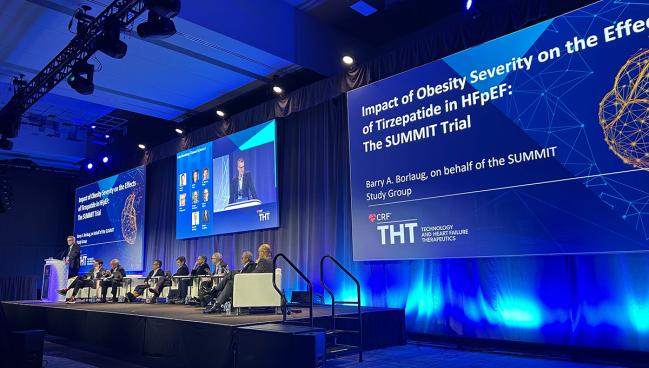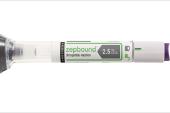Tirzepatide Helps in HFpEF Across Spectrum of Obesity Severity
The SUMMIT analysis did show that some of the benefits of treatment are greater when more weight is lost.

BOSTON, MA—Tirzepatide improves outcomes in patients with heart failure with preserved ejection fraction (HFpEF) and obesity, no matter how much excess body weight they have, according to an analysis of the SUMMIT trial.
The risk of cardiovascular death or worsening HF was lower with active treatment versus placebo across tertiles of either body mass index (BMI) or waist-to-height ratio at baseline, Barry Borlaug, MD (Mayo Clinic, Rochester, MN), reported here at THT 2025.
But there were some signals of differential effects on other outcomes based on the degree of adiposity—changes in quality of life and exercise capacity appeared to be greater among patients who started the trial with higher BMIs.
Inclusion in the trial was based on BMI, not waist-to-height ratio, Borlaug noted during a panel discussion following his presentation. Still, “it probably is going to be worthwhile” to calculate both measurements in patients. He noted that in the PARAGON-HF trial, a greater proportion of patients with HFpEF had obesity according to waist-to-height ratio versus BMI (96% vs 49%). “You are getting very different answers” with the two measures, he said.
Commenting for TCTMD, Nancy Sweitzer, MD, PhD (WashU Medicine, St. Louis, MO), editor-in-chief of Circulation: Heart Failure, said that “clearly, this idea that adipose tissue is bad and less adipose tissue is good is becoming a very strong theme.”
It’s not surprising that patients with the most-severe obesity derived the greatest benefits in terms of quality of life in SUMMIT, she added, but said “it’s reassuring that there isn’t some level of obesity that’s so great that you don’t benefit.”
Obesity Severity in SUMMIT
In the United States, about two-thirds of patients with HFpEF have the obesity phenotype, and the pathophysiological abnormalities present in this setting all correlate to the amount of excess body weight, and body fat in particular, Borlaug said.
The main results of the SUMMIT trial, reported last year, showed that tirzepatide—a dual glucose-dependent insulinotropic polypeptide (GIP) and glucagon-like peptide-1 (GLP-1) receptor agonist—reduced the risk of CV mortality and worsening heart failure and improved quality of life and 6-minute walk distance in patients with HFpEF and obesity.
It’s reasonable, Borlaug said, to suspect that the effects of treatment may differ based on the degree of general adiposity (measured with BMI) or central adiposity (measured with waist-to-height ratio) or based on the amount of weight lost.
After dividing the SUMMIT participants into tertiles, he and his colleagues found that patients with higher BMIs at baseline tended to be younger, were more likely to be white and less likely to be Asian and had lower NT-proBNP levels and higher C-reactive protein (CRP) levels.
Those with higher waist-to-height ratios at baseline were more likely to be white and less likely to be Asian, and they had higher CRP levels, greater impairments in exercise function, and more severe kidney dysfunction.
For both metrics, patients with more body fat at baseline had lower quality of life based on the Kansas City Cardiomyopathy Questionnaire (KCCQ) clinical summary score and were more likely to be women, to have higher NYHA class, and to have significant volume overload.
Despite these differences, the impact of tirzepatide on CV mortality or worsening heart failure was consistent across BMI and waist-to-height ratio groups, Borlaug reported.
Treatment had greater beneficial effects on quality of life and exercise capacity at higher levels of baseline BMI, however. Improvement in KCCQ clinical summary score, for instance, ranged from 4.6 points in patients with a BMI below 34.3 kg/m2 to 9.7 points in those with a BMI of 40 kg/m2 or higher. Similarly, for 6-minute walk distance, there was no significant change in the lowest BMI tertile but an increase of 25.5 m in the highest tertile.
The researchers also showed that changes in KCCQ, 6-minute walk distance, CRP level, and systolic BP were greater among patients who lost more weight with tirzepatide (P < 0.05 for all trends).
‘Paradigm-Changing’ Medications
Sweitzer, speaking with TCTMD, indicated that she would give tirzepatide, and similar drugs, to any patient who would derive some degree of benefit. “The drugs are paradigm-changing,” she commented. “It’s just something we’ve never been able to do for our patients, and so far, it seems only good, as long as you’re not too nauseated or having too much GI distress.”
Those side effects can be managed, however, and the quit rates are low, Sweitzer pointed out, adding that she doesn’t have much concern with using these types of agents in patients with HFpEF.
Clearly, this idea that adipose tissue is bad and less adipose tissue is good is becoming a very strong theme. Nancy Sweitzer
There is a potential risk with using them in patients with heart failure with reduced ejection fraction (HFrEF) because they’ve been shown to reduce heart mass. That’s “fine when you have HFpEF and probably [LV hypertrophy] and thick walls, but in HFrEF, where you need every myocyte you can get, I think there is some concern about using these medications. And I think that’s why we haven’t seen a trial in HFrEF.”
That said, Sweitzer added that she would use these drugs in a HFrEF patient who will likely need a heart transplant but is not eligible due to excess body weight. In that case, “I put them on these medicines because I feel like getting them a transplant in the end is going to be the desirable outcome, and so I’m willing to take a little bit of risk right now.”
Though there are some remaining questions around the impact of tirzepatide and similar drugs on frailty and longer-term safety, as well as issues related to the high cost of the agents, Sweitzer said she remains enthusiastic about their use.
“Diabetes goes down, blood pressure goes down, and they’re going to lead to a massive reduction in cardiovascular risk in a very high-risk group of people. I don’t see a lot of downside with that,” she said. “Even if there are some risks, it would seem like they’re going to be overwhelmed by the reduction in cardiovascular risk.”
Todd Neale is the Associate News Editor for TCTMD and a Senior Medical Journalist. He got his start in journalism at …
Read Full BioSources
Borlaug BA. Impact of obesity severity on the effects of tirzepatide in HFpEF: the SUMMIT trial. Presented at: THT 2025. February 11, 2025. Boston, MA.
Disclosures
- Borlaug reports receiving research support from the National Institutes of Health/National Heart, Lung, and Blood Institute, the Department of Defense, Axon, AstraZeneca, Corvia, Medtronic, Novo Nordisk, Rivus Pharmaceuticals, and Tenax Therapeutics and consulting or serving on advisory boards for Amgen, Aria, Boehringer Ingelheim, Edwards Lifesciences, Eli Lilly, Janssen, Merck, Novo Nordisk, NGMBio, ShouTi, and VADovations.






Comments